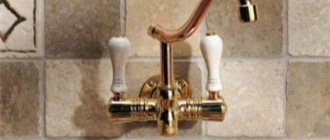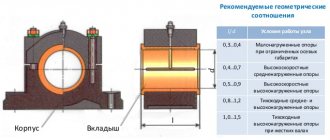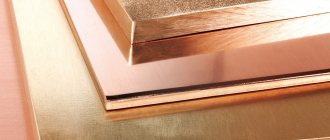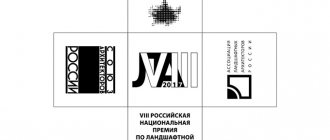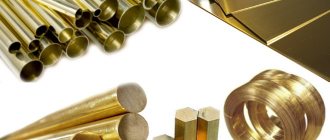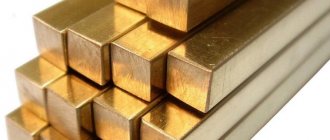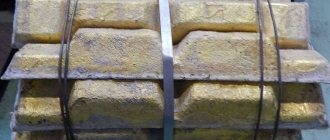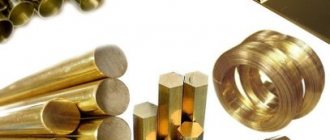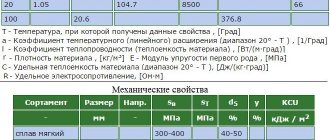General information
Conductor materials in electrical engineering include metals, their alloys, contact metal-ceramic compositions and electrical carbon.
Metallic substances are conductors of the first kind and are characterized by electronic conductivity; the main parameter for them is electrical resistivity as a function of temperature. The range of resistivity of metal conductors is very narrow and ranges from 0.016 μΩ×m for silver to 1.6 μΩ×m for heat-resistant iron-chromium-aluminum alloys.
The electrical resistance of graphite passes through a minimum with increasing temperature, followed by a gradual increase.
Based on the type of application, conductor materials are divided into groups:
· high conductivity conductors
— metals for power transmission line wires and for the manufacture of cables, winding and installation wires for the windings of transformers, electrical machines, equipment, inductors, etc.;
· construction materials
— bronze, brass, aluminum alloys, etc., used for the manufacture of various current-carrying parts;
· high resistance alloys
- intended for the manufacture of additional resistances for measuring instruments, standard resistances and resistance stores, rheostats and elements of heating devices, as well as alloys for thermocouples, compensation wires, etc.;
· contact materials
— used for pairs of permanent, breaking and sliding contacts;
· soldering materials
all types of conductor materials.
In addition to purely electrical properties, in order to carry out the necessary technological processing and ensure specified service life in operation, conductor materials must have sufficient heat resistance, mechanical strength and ductility.
Copper
Pure copper ranks next in electrical conductivity after silver, which has the highest conductivity of all known conductors. High conductivity and resistance to atmospheric corrosion, combined with high ductility, make copper the main material for wires.
In air, copper wires oxidize slowly, becoming covered with a thin layer of CuO oxide, which prevents further oxidation of copper. Copper corrosion is caused by sulfur dioxide SO2, hydrogen sulfide H2S, ammonia NH3, nitric oxide NO, nitric acid vapor and some other reagents.
Conducting copper is obtained from ingots by galvanic purification in electrolytic baths. Impurities, even in insignificant quantities, sharply reduce the electrical conductivity of copper, making it unsuitable for current conductors, therefore only two grades of copper, M0 and M1, are used as electrical copper.
Almost all conductive copper products are made by rolling, pressing and drawing. Thus, wires with a diameter of up to 0.005 mm, tapes with a thickness of up to 0.1 mm, and copper foil with a thickness of up to 0.008 mm can be produced by drawing.
Conducting copper is used both in annealed form after cold working (soft copper grade MM) and without annealing (hard copper grade MT).
At heat treatment temperatures above 900 °C, due to intensive grain growth, the mechanical properties of copper sharply deteriorate.
In order to increase the creep strength and thermal stability, copper is alloyed with silver in the range of 0.07-0.15%, as well as magnesium, cadmium, zirconium and other elements.
Copper with silver additives is used for windings of high-speed and heat-resistant high-power machines, and copper alloyed with various elements is used in commutators and slip rings of heavily loaded machines.
Brass
Alloys of copper and zinc, called brasses, are widely used in electrical engineering. Zinc dissolves in copper up to 39%.
In various brands of brass, the zinc content can reach up to 43%. Brasses containing up to 39% zinc have a single-phase solid solution structure and are called a-brasses. These brasses have the greatest ductility, so they are used to make parts by hot or cold rolling and drawing: sheets, strips, wire. Without heating, parts of complex configurations can be made from sheet brass using deep drawing and stamping.
Brasses with a zinc content of over 39% are called a+b-brasses or two-phase and are used mainly for shaped castings.
Two-phase brass is harder and more brittle and can only be pressed when hot.
The addition of tin, nickel and manganese to brass increases the mechanical properties and anti-corrosion resistance, and the addition of aluminum in composition with iron, nickel and manganese gives the brass, in addition to improving the mechanical properties and corrosion resistance, high hardness. However, the presence of aluminum in brasses makes soldering difficult, and soldering with soft solders becomes almost impossible.
· brass grades L68 and L63
Due to their high ductility, they are easily stamped and can be bent; they are easily soldered with all types of solders. In electrical engineering they are widely used for various live parts;
· brass grades LS59-1 and LMTs58-2
used for the manufacture of rotor (squirrel) cages of electric motors and for current-carrying parts made by cutting and hot stamping; soldered well with various solders;
· brass LA67-2.5
used for cast current-carrying parts of increased mechanical strength and hardness that do not require soldering with soft solders;
· brass LK80-3L and LS59-1L
widely used for cast current-carrying parts of electrical equipment, for brush holders and for casting rotors of asynchronous motors. They accept soldering well with various solders.
Recommendations for selection
The cost of silumin products is lower than brass, so many users purchase budget products. Even if devices made from an alloy of aluminum and silicon are treated with care and shocks are avoided, destruction inside the housing can occur due to a water hammer in the water supply system.
Silumin cranes are used for no more than 1.5 - 2.5 years and, most often, cannot be repaired. They are installed in temporary cabins, trailers, and dachas.
Brass faucets are of high quality and are used in bathrooms of apartments and private houses. The products are designed to last for a long time; gaskets and valve axle boxes are replaced in them, so we can talk about the possibility of repair.
Conducting Bronzes
Conducting bronzes belong to copper alloys, the need for their use is mainly caused by the insufficient mechanical strength and thermal stability of pure copper in some cases.
Read also: Safety precautions when working with a soldering iron
The general range of bronzes is very extensive, but only a few brands of bronzes have high electrical conductivity.
· cadmium bronze
refers to the most common conductor bronzes. Of all the grades, cadmium bronze has the highest electrical conductivity. Due to its increased abrasion resistance and higher heat resistance, this bronze is widely used for the manufacture of trolley wires and collector plates;
· beryllium bronze
refers to alloys that gain strength as a result of aging. It has high elastic properties, stable when heated to 250 °C, and electrical conductivity is 2-2.5 times greater than the conductivity of other grades of general-purpose bronzes. This bronze has found wide application for the manufacture of various spring parts that simultaneously act as a current conductor, for example: current-carrying springs, certain types of brush holders, sliding contacts in various devices, plug connectors, etc.;
· Phosphor bronze
has high strength and good spring properties; due to its low electrical conductivity, it is used for the manufacture of spring parts with low current densities.
Cast current-carrying parts are made from various grades of machine-building cast bronzes with a conductivity within the range of 8-15% of the conductivity of pure copper. A characteristic feature of bronzes is low shrinkage compared to cast iron and steel and high casting properties, therefore they are used for casting various current-carrying parts of complex configurations intended for electrical machines and apparatus.
All brands of cast bronzes can be divided into tin and tin-free, where the main alloying elements are Al, Mn, Fe, Pb, Ni.
Stainless steel.
It is resistant to corrosion in aggressive environments. This is its main property. The alloy is subjected to alloying; the main alloying element is chromium, and the more of it, the more resistant the steel is to the corrosive effects of, for example, acids. The chromium content can be from 12 to 20% (if chromium is 17 percent or more, the alloy will withstand exposure to 50% concentration of nitric acid). To enhance this wonderful property of stainless steel and give it additional physical and chemical properties, it is also alloyed with nickel, titanium, niobium, and molybdenum. The ratio of certain elements and their quantity determines the grade of steel and its resistance to strong acids (phosphoric, sulfuric, etc.)
How to explain such corrosion resistance? At the interface of the chromium-containing alloy and the medium, a film of oxides and other insoluble compounds forms, which protects the surface. Many different products are made from stainless steel. And not only in industry. It is not only durable, but also aesthetically pleasing material - it is used very often in architecture and in the design of household items.
Laser cutting of stainless steel
Laser cutting of aluminum
Laser cutting of copper
Laser cutting of brass
This is the most common non-ferrous metal. Resistant to corrosion in the air (only carbon dioxide contained in the air forms a greenish coating - patina), in fresh and salt water, with alkaline solutions, but dissolves in strong acids (nitric, sulfuric). It is easily processed by soldering and pressure, but its casting properties are not very high. Deoxidized and oxygen-free copper is used in electronics.
Copper alloys are wear-resistant, just like pure copper is anti-corrosion.
Based on the interaction of copper with impurities, 3 groups are distinguished:
- Solid solutions: with aluminum, zinc, antimony, nickel, tin, iron (electrical and thermal conductivity decreases);
- Insoluble impurities: bismuth, lead (electrical conductivity does not change, but pressure treatment is difficult);
- Brittle chemical compounds: sulfur and oxygen (oxygen reduces strength, and sulfur promotes better cutting).
Copper and copper alloys have long been used to this day in the manufacture of dishes, household items, and are used in art and architecture.
Aluminum
The characteristic properties of pure aluminum are its low specific gravity, low melting point, high thermal and electrical conductivity, high ductility, very high latent heat of fusion and a durable, although very thin, oxide film covering the surface of the metal and protecting it from the penetration of oxygen inside.
Low density makes aluminum the basis of lightweight structural materials; Great plasticity makes it possible to apply all types of pressure treatment to aluminum and obtain from it sheets, rods, wire, pipes, the thinnest foil, deep-drawn stamped parts, etc.
Good electrical conductivity ensures the widespread use of aluminum in electrical engineering. Since the density of aluminum is 3.3 times lower than that of copper, and the resistivity is only 1.7 times higher than that of copper, then aluminum per unit mass has twice the conductivity of copper.
A durable oxide film quickly covers a fresh cut of metal even at room temperature, providing aluminum with high resistance to corrosion in atmospheric conditions.
Sulfur dioxide, hydrogen sulfide, ammonia and other gases found in the air of industrial areas do not have a noticeable effect on the corrosion rate of aluminum. The effect of water vapor on aluminum is also insignificant. In contact with most metals and alloys that are noble in the electrochemical potential range, aluminum serves as an anode and, therefore, its corrosion in electrolytes will progress.
To avoid the formation of galvanic couples in a humid atmosphere, the junction of aluminum with other metals is sealed by varnishing or other means.
Long-term tests of aluminum wires have shown that they are not inferior to copper wires in terms of resistance to corrosion.
Table 1. Main characteristics of conductor materials
Density, kg/m 3 10 3
Electrical resistivity at 20 °C, Ohm×m 10 –6
Average temperature coefficient of resistance from 0 to 100 °C, 1/deg
Wires, cables, tires, conductors of squirrel-cage rotors, housings and bearing shields of small electrical machines
Cadmium bronze - contacts, phosphor bronze - springs
Duralumin. Properties of duralumin. Application of duralumin
Dural is short for duralumin. This is an alloy. Its basis, as the name suggests, is the 13th element of the periodic table. Aluminum accounts for 93% of the alloy's mass. 5% is copper. The rest is manganese and sometimes iron and magnesium. What does the prefix “dur” have to do with it? There is no such element. But there is a city in Germany.
The photo shows a detail made of duralumin
It was in Düren in 1906 that the chemist Alfred Wilm created a new alloy. It became a breakthrough in metallurgy. For more than a century, its specialists did not know how to use aluminum, which is soluble even in coffee, tea and, in general, any liquids containing at least weak acids and alkalis. Industrialists were also confused by the softness of the 13th element. However, he was unrecognizable in duralumin.
Properties of duralumin
Alloy of duralumin – success in a series of disappointments. Alfred Wilm selected the composition, as they say, at random. Having headed the metallurgy sector at a research institute, the chemist set out to create a high-strength aluminum alloy. There were already dozens of failed attempts in the report.
Dural is a lineup formed on one Friday. Having received the alloy, Wilm and his colleagues measured the hardness of the raw material. The figure of 70 conventional units seemed fantastic to scientists. Perhaps they were tired by the end of the week, the Germans thought and went to rest, deciding to recheck the calculations on Monday. However, at the beginning of the week the hardness was already 100.
Spontaneous hardening over time is a distinctive feature of the duralumin alloy. Sheet , in wire or ingots, the composition is actively strengthened for several days after smelting.
Then, the rate of improvement slows down, but does not come to naught. Over the years, the performance parameters of duralumin do not deteriorate, like other alloys, but improve. Scientists call this spectacular aging.
In the laboratories of the Alfred William Institute, aging took place naturally at a temperature of 20-25 degrees. During the war years, when duralumin became a strategically important raw material, an artificial hardening method was invented. It was possible to reduce it to 3-4 hours by heating it to 500 degrees and sharply cooling it in water or saltpeter for 1-2 minutes.
In the photo there is a boat made of duralumin
Before aging, aluminum duralumin is soft and pliable, just like pure metal. After quenching, the alloy becomes tough and hard, compacting to 2,800 kilograms per cubic meter. While durable, the duralumin sheet remains lightweight. The weight is due to aluminum, whose specific gravity is 3 times less than copper. Strength is a consequence of interaction with 7% ligature.
The composition is resistant to high temperatures, softens at 650 degrees. Aluminum duralumin is not resistant to corrosion The parts have to be clad, that is, covered with a layer of 100 percent aluminum. In its original form it is protected by an oxide film. It blocks the access of oxygen, saving the metal from its destructive effects and moisture.
Application of duralumin
In the 21st century, duralumin is the basis of aircraft construction. Interestingly, the first use of the alloy was also associated with aircraft. In 1911, a frame for an airship was made from duralumin. This is a combination of a power plant and a balloon. To move through the air, it was necessary to lighten the structure without sacrificing its reliability.
For airships of the early 20th century, only one type of duralumin was offered. Over the past century, about 10 brands have been developed, varying in composition and purpose. alloy D16t is used for aircraft parts
The photo shows duralumin products for industrial purposes
The composition includes not 3-4 standard metals, but 9. The alloy includes: copper, iron, silicon, magnesium. Nickel, titanium, manganese and zinc are also present. At the same time, the amount of aluminum is not reduced - the same 93%.
Welding of duralumin is not carried out in aircraft construction. The structures are held in place by rivets and other fasteners. The same 16th duralumin can play their role. Connections made from it are shear-resistant, that is, they resist the collapse of joining surfaces and, conversely, their divergence under increased loads.
The 16th alloy is purchased not only for aircraft, but also for cars. The material makes them lighter, which means improving dynamics, smooth running, and reducing the cost. D16 is used not only for hulls and bodies, but also for internal components, for example, duralumin pipes . Their placement inside a car is possible due to the alloy’s resistance to high temperatures.
Alloy D16 can also be used to make a duralumin boat . With proper care, it lasts about 20 years. The product is riveted, so it is rough in appearance, with sharp edges. The rusting of the ship also fails. But, it is more reliable than wooden one.
Some models are made of D18 duralumin. It contains a reduced percentage of copper and magnesium. This makes the alloy extremely ductile. It is easy to give this composition any shape.
In the photo there is a duralumin spoon for fishing
B95 duralumin is also distinguished by its high ductility. The profile from it is easily connected by spot welding. The material is used for the design of facades, metal structures of buildings, hanging cornices and decorative details in architecture. They are produced in an environment of inert gases. This is a condition for welding work with duralumin, eliminating the formation of pores at the joints of parts.
Scrap duralumin grades D17 and D19 are materials with increased heat resistance. In the 17th alloy there is less copper and more magnesium, in the 19th alloy it is the other way around. Both compositions are raw materials for rivets. Sometimes, after the digital designation of the brand, an additional letter is placed. So, “T” is evidence of heat treatment, that is, hardening of the alloy.
“M” indicates the presence of plating, that is, resistance to corrosion. The nuances of making duralumin do not change the basic principle of their production. It all started with the D1 brand. This is a composition from 1908, still in production. Let's delve into the production process.
Extraction of duralumin
Duralum is not mined, because it is an alloy, not pure metal. Its components, mainly aluminum, are extracted from the depths. It is found only in compounds - ores and minerals.
Therefore, industrialists carry out electrolysis of the oxide of the 13th element in the presence of cryolite. The result of the work is a precipitate of pure aluminum. All that remains is to add to it the alloying metals necessary to obtain duralumin .
Buying the correct duralumin that complies with GOST 21631 means purchasing an alloy into which additives were introduced sequentially. Alloying metals are not poured into molten aluminum all at once. The order depends on the brand of duralumin . As a rule, copper is combined with aluminum first. Melts are made in electric furnaces.
In the photo there is a duralumin carabiner for climbers
The hardening process is also part of duralumin production . The time it is kept in saltpeter baths or containers with water depends on the thickness and number of parts placed in them. 1-2 minutes is just an approximate limit. The temperature also varies. If it is tempered in water, it is not heated to more than 30 degrees. The permissible heating of nitrate is 51 on the Celsius scale.
Price of duralumin
How much duralumin costs depends on the type of products and their dimensional parameters. Rods, disks, and wire are made from the alloy. The most in demand is sheet duralumin. Samples 1.2 meters wide, 3 meters long and 0.5 centimeters thick, for example, cost 200-250 rubles.
This is the price of duralumin per kg for wholesale purchases. Products are rarely purchased at retail. Therefore, most suppliers ask to clarify the cost for piece orders.
There is also a market for duralumin scrap . Here the price tag is also set per kilogram. On average, you manage to earn 50-60 rubles. The price tag varies depending on the host company and its region of location.
What are copper and brass called?
The first difference between copper and brass is that copper is a metal, an element of the Table of Chemical Elements, a simple substance, and brass is an alloy of two metals - copper and zinc, or strictly scientifically - a solid copper-zinc solution. In simple brasses, zinc is the only additive to copper or the only alloying element. In complex brasses, other elements are added to the copper-zinc solution - iron, nickel, tin, arsenic, aluminum. Their amount is several times less than the amount of zinc, which distinguishes brass from another group of copper alloys - bronze. Just as a small pinch of spices changes the taste of a dish, so small additions of 1-2% of third elements to a copper-zinc solution have a strong effect on the properties of brass: strength, ductility. corrosion resistance and manufacturability.
Why was zinc added to copper and why are zinc statues not cast?
Copper is alloyed with zinc to create alloys with properties that copper and zinc do not have individually. Copper is a good conductor of heat and electricity. Copper is ductile, stretches, and can be stamped. Copper wires, copper tubes for refrigerators, heaters or air conditioners, copper utensils fully realize the properties of copper, such as heat and electrical conductivity, and high ductility. Corrosion resistance and chemical inertness to household solutions make it possible to produce copper cookware, frying pans, and pots. But the downside of the properties of copper is that it has insufficient strength, hardness, corrosion resistance and high cost for widespread use in technology as a structural material. For five thousand years, people have been modifying copper by adding other metals to the melt to measure its properties.
Zinc has even lower strength than copper. Unlike copper, it is extremely fragile in the cast state - the relative elongation of cast zinc is δ = 0.5-1%, despite the low cost and good casting properties, monuments are not cast from zinc. After cold rolling or wire drawing, the ductility of zinc increases sharply to δ = 25-60%. Zinc is used as a protective anti-corrosion coating. An oxide film forms on the surface of zinc and protects the metal from corrosion.
An alloy of copper and zinc creates a new structural material - brass, which is superior to its parents in strength, manufacturability, while maintaining high corrosion resistance and ductility.
Read also: Lever mechanical measuring instruments
Stainless steel faucets
When choosing a faucet made of brass or stainless steel, it is important to determine the characteristics that interest you first. Stainless steel can be obtained by improving ordinary steel, as a result of enhancing its properties by adding impurities of other metals. Most often, the following reinforcing components are used: copper, nickel, chromium, manganese, titanium, sulfur, silicon and some others.
Below are stainless steel faucets from our company:
Advantages
The advantages of stainless steel include:
- heat resistance,
- practicality,
- oxidation resistance,
- resistance to mechanical loads,
- inertness towards chemically active substances.
Stainless steel faucets faithfully serve their owners for many years without loss of performance characteristics. An additional advantage is the visual appeal and wide variety of designer products. This allows you to choose a model that will harmoniously fit into any interior.
Flaws
Assessing the pros and cons of stainless steel faucets, users note that their main disadvantage is their high cost . However, it is more than compensated for by its excellent performance characteristics.
How to distinguish it from other materials
Comparing the features of various materials, it is worth noting that there are many fakes on the market, which are quite difficult to distinguish from the original. To make sure that you have a quality product in front of you, take it in your hands. Stainless steel faucets are quite heavy . If the weight is practically not felt, the product is most likely made of silumin, which is much worse than stainless steel or brass.
Another feature of stainless steel is that it is not attracted by a magnet . However, when choosing, this characteristic is not as obvious as the weight of the product.
New properties of brass compared to copper
Alloying copper with zinc and other metals created 12 grades of cast brass and 34 grades of wrought brasses that can be stamped, forged, and drawn. When asked how brass differs from copper, I would like to clarify, but what kind of brass are you asking about? Tompaki - brass L96 and L90 with a high copper content differ little from copper. They are red in color, can be stamped well, and are 2-3% stronger than copper with a loss of ductility. Tompaki can easily be confused with copper.
An increase in the percentage of zinc gives brass a yellow color and increases the strength of the alloy. Brasses with a zinc content of about 30% - L68, L70 are superior to copper in strength by one and a half times and in ductility by 15%.
Add a little lead to a copper-zinc alloy and you get a new type of brass - lead. There is a 99% chance that your kitchen or bathroom faucet is made of lead brass. It is hidden under a layer of shiny chrome or matte nickel. Unscrew the valves from the faucet and look inside, you will see yellow brass. Lead brass not only brings pleasure to lovers of water procedures, but it is loved by turners for its good machinability on machines and is affectionately called “loose”. Lead brass does not produce twisted chips when turning or drilling. Its shavings fall out from under the cutter like golden sand. The difference between copper and brass is that copper is a viscous and soft material, which creates difficulties during machining.
If you need to make a ship's bell, you cannot do without adding tin to the copper-zinc solution. Tin gives pewter brasses seawater resistance and strength for long-term use.
Aluminum brass LA85-0.5 is a material for jewelry. Half a percent of aluminum gives this brass a golden shine, and high ductility makes it possible to produce the finest wire and ribbon for costume jewelry, decorations, and military insignia. Future jewelers learn the secrets of craftsmanship using brass L62 and L68. The technological and mechanical properties of these brasses are close to those of 583 gold alloy, and the cost is disproportionately lower.
How to distinguish copper from brass
The most reliable and correct way to distinguish copper from brass is to do a chemical analysis. Less reliable - in color. Copper is always red, and brass is yellow except in two cases. Brass grades with high copper content L96 and L90 are red. A small amount of zinc - 4% and 10%, respectively, does not allow the copper-zinc alloy to turn yellow. Such alloys have a separate name “tompak”. The second case of reddening of brass is less known to the layman. Yellow brass with a high zinc content is susceptible to a special type of corrosion - dezincification. The corrosive environment leaches zinc from the brass and increases the concentration of copper. The surface of brass semi-finished products loses its yellow color with the loss of zinc. A file, scraper or any tool that is used to clean the surface of brass in order to get to the yellow metal that is hidden under the corroded surface will help you decide here.
Brass is an alloy of copper and zinc. Other elements may be added. The more different components there are in brass, the cheaper it is. However, this alloy is stronger than pure metal. It does not oxidize so quickly and is not so plastic. And, most importantly, more affordable.
What is more expensive - copper or brass? The answer to this question is clear. Copper costs an order of magnitude higher than brass. The price may differ by two times. The reason is the composition on which the characteristics of these materials depend.
Brass or aluminum, which is stronger?
Plates are made from different materials, the choice of which is entirely a matter of taste and preference of the customer.
Some are ready to be content with inexpensive plastic just to indicate their location to clients, while others make the sign one of the elements of their company’s PR campaign and therefore carefully select the material. Plastic, of course, will not suit such a customer. It is best to order a sign made of metal. But metal can be different, each type has its own characteristic features that must be taken into account. The most common are brass signs and aluminum signs.
The main advantage of the former is their visual appeal and long service life. However, brass signs require very serious maintenance. Especially if they are placed outdoors or in rooms with high humidity. Under such conditions, brass oxidizes and corrodes, traces of which can only be removed with serious effort. Moreover, this will have to be done periodically.
In addition, since brass is a heavy metal, signs made from it require serious fastening. You can't do it without screws. To make the fastener heads less noticeable against the general background, you can use bolts and screws made of the same metal or disguise them on top with special plugs.
In this regard, aluminum signs are much easier to use. This material is resistant to moisture, has a pleasant silver color and shine, which remain even after several decades of use. Glossy aluminum signs can be easily cleaned from dirt, making them ideal for outdoor placement. Due to their lightness, such signs are easily attached to walls and are held in place even with ordinary double-sided tape. Therefore, if you need a sign on the wall, drilling of which is unacceptable, then without hesitation you should opt for duralumin.
Another big plus of aluminum signs is that they leave a huge scope for creativity. Modern equipment allows us to make signs from this metal of any shape and size, which in no way affects their quality. The smooth surface of duralumin signs perfectly holds the self-adhesive film, thanks to which you can make bright and colorful stands with any information. This, as well as the affordable price of aluminum, make such signs more and more popular. Today they can be found not only on facades, but also in factory workshops. And in a variety of enterprises, and in educational, cultural and medical institutions.
Source
Comparative characteristics
The appearance of brass depends on how much copper it contains. If more than 80%, then it will be very difficult to distinguish the alloy. However, the more zinc, the lighter the shade; it loses its reddish notes and becomes more yellow. Let's compare the general physical characteristics of these materials:
| Index | Copper | Brass |
| Weight | Heavier | Easier |
| Color | Pinkish brown | Golden yellow |
| On impact | Low sound | Alt |
| Density | Plastic | Solid |
| Shavings | Spiral | Needle |
As follows from the table, despite their similar composition, copper and brass are very different in both chemical and physical characteristics.
How to tell - copper or brass?
Before starting a comparative analysis, it is necessary to clean the metal from dirt and patina. There are ways to tell the difference at home without using tools. But it is better to reliably determine whether it is an alloy or a metal, using a number of possible methods.
As for the shade, the difference may be small for materials such as copper and brass. It all depends on the level of metal content in the alloy. However, there are still differences. First of all, you need to completely clean the object under study from dirt. Studying should be done under bright, white lighting. Either sunlight or fluorescent light will do.
Copper will have a brown tint with a red or pinkish tint. The color range of brass lies in yellow tones. However, to be completely sure, it is better to take an item that is definitely made of copper and visually compare its color with the shade of the object being studied.
How to identify copper or brass by sound? If the object is large enough, then this is one of the simplest and most accurate methods of analysis. You need to hit the object with some metal thing and listen carefully to the pitch of the sound. Copper, as a softer material, will produce a lower, even dull sound. Brass, on the contrary, will sound loud and high.
Hardness
How to test brass at home? It is enough to hit it with a hard object. Metal without impurities is softer and will be deformed. The alloy, on the contrary, will withstand all blows. After all, brass was created in order to give rigidity to flexible copper.
Read also: Intercom connection diagram visit to an apartment building
Marking
If we are talking about a separate product, then there is often a marking on it. It will give accurate information about the composition. Copper items are designated by a combination of letters, the first of which is “M,” and for brass items, “L.” In the USA, brass is marked C2, C3 or C4. In the European Union, the first letter of the label will always be S. However, there are a few more points that will help determine the composition of the item. The following are important:
- Copper is designated by the symbols A,B,C,D.
- On things that consist of an alloy, the letters L, N, M, P, R are indicated.
- If the product has Cu Zn symbols, then it is also brass.
Weight and density
What is heavier - copper or brass? The alloy will be lighter than metal without impurities. But if the subject being studied is small, then it will not be possible to do without scales.
Chip shape
What are the differences between brass and copper in chips? Since the alloy is harder, the chips, accordingly, will be sharp, needle-shaped, and crumbly. Similar to grated carrots. As for copper, its shavings are spiral and circular. Similar to the peel of a peeled apple. However, for comparison you need to have access to the machine.
Acid analysis
Brass is an alloy of what metals? Copper and zinc. However, if the copper content is above 96%, then all the above methods will not help distinguish pure metal from an alloy. In this case, hydrochloric acid will come in handy. If you drop it on metal without impurities, there will be no reaction. Only the patina will come off. However, due to the fact that it contains zinc, brass will develop a white oxide.
Analyzers
This is one of the most expensive, but at the same time reliable methods for determining the composition of a material. Such a device, reacting with metal, displays detailed information about its constituent parts on the liquid crystal screen. In this way, it will be clear whether the object being studied contains any impurities, or whether it consists of 99% or more percent copper.
Heating
The melting point of copper and brass is different. However, even without melting the metal, you can find out about its composition. For this method, you need to prepare a gas burner. You need to heat the object to a temperature of 600 degrees. Zinc oxide will appear on the alloy in the form of a pale, ashy coating.
Along with these two metals, bronze is often used. It is an alloy of copper with tin, aluminum, silicon and other substances. How to distinguish copper from bronze and brass? The methods are the same. The main thing is to know the distinctive features of bronze. First of all, it is very strong; some alloys are stronger than steel. Bronze items are much less susceptible to corrosion and have a different shade.
Where are copper and brass used?
There are items that are made only from pure copper, and there are those for which brass is better suited. The reason is the different physical properties of these materials. If an object is supposed to be strong, hard, rigid (for example, a tool), then with a 95% probability we can say that it is made of brass. And if flexibility and high electrical and thermal conductivity are required, then copper is used. It is impossible to say which is better - copper or brass: each of the materials adequately performs its functions.
Copper is most often used to make wires. The thermal conductivity of brass and copper is different. It is a pure alloy that can provide a high speed of electrical current.
Due to its ductility, copper is in demand for wire production. It has high strength indicators. Copper wire is used in such industries as electrical engineering, power generation, shipbuilding, and automobile production.
Copper pipes are highly valued because they have unique properties. They are resistant to temperature changes and are not afraid of ultraviolet radiation. Moreover, there are technologies that make it possible to make copper pipes seamless with a round cross-section. They are actively used for transporting liquids and gases.
Copper is also used in the construction industry for roofing. At the same time, the patina, which appears after some time, acts as a certain protective screen that protects the roof from temperature changes, aggressive effects of moisture and sunlight.
As for brass, this is also a very popular material. First of all, it is an ideal metal for the production of sanitary ware. The fact is that brass does not rust due to constant exposure to moisture, but only darkens. And this plaque can be removed without any problems. Therefore, brass faucets, pipes, taps are invariably in high demand.
Brass screws, bolts and nuts are prized. They are strong and durable. In addition to technicians, brass is also held in high esteem by creative individuals. It is used to create magnificent jewelry, interior items, and is used to create decorative elements and fittings for windows and doors. Brass is even called the “eternal metal” because it retains its original appearance for a long time.
How to choose copper and brass products?
In order not to be disappointed in the purchase, you should decide in advance for what purposes the product will be used.
Important! Purchases should only be made in stores with a proven reputation. Situations often arise when a copper item turns out to be a fake with sputtering, or a brass item contains too many foreign impurities.
It is not so difficult to distinguish copper products from brass ones. It is important to carefully examine the metal object using the proposed analysis methods.
Brass or bronze: several ways to determine the alloy
There are several ways to understand which alloy is in front of you.
- It is necessary to heat the alloys to a temperature of 600 degrees in the open air. A thin, ashen-colored film of zinc oxide forms on the surface of the brass. At that time, the bronze will not lose its original appearance.
- As it heats up, brass becomes more flexible and ductile. The opponent will not change his properties.
- You can also determine whether it is brass or bronze using mechanical action. It is enough to bend a piece of metal at a right angle. In the first case, the material will maintain its integrity, in the second, it will break.
- Treat bronze and brass filings with nitric acid. All that is required is to pour 0.05 g of material into 10 ml of the substance and leave for a while. After dissolving the alloys, bring the contents to a boil and let stand for half an hour. In a vessel with brass the solution will become transparent, in a beaker with bronze a white precipitate will appear.
- By exposing materials to a magnet, you can find that a bronze alloy is slightly magnetic, while a brass alloy is not.
